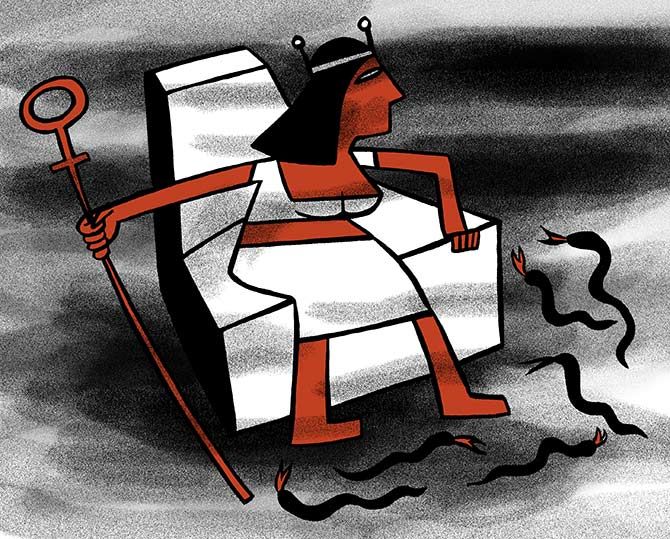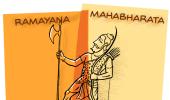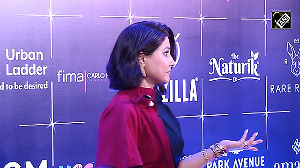Inclusion has never been a straight road and stories from ancient cultures show it has always been a struggle to accord equal status to all genders and species, says Arundhuti Dasgupta.
Illustration: Uttam Ghosh/Rediff.com

When Arvind Subramaniam held up a pink Economic Survey for the cameras to show how committed his team is to the cause of gender equality, he was indulging in the popular pastime of tokenism.
He is not alone in his inability to understand the cause he wishes to align with; women, gender, equal opportunity have been turned into meaningless buzzwords that slip as easily off the tongue of politicians as they do off the pages of company annual reports.
While Subramaniam has been roundly criticised and ridiculed, painting just him into a corner would be an injustice.
Recently PepsiCo CEO Indra Nooyi ran into a storm with her comments on popular podcast series Freakonomics, about designing a special snack for women.
She was thinking of a snack that she said would be: 'Low-crunch, the full taste profile, not have so much of the flavour stick on the fingers, and how can you put it in a purse? Because women love to carry a snack in their purse.'
Women, she added, did not want to chomp their way through a packet of Doritos in public as men do.
Social media dashboards reported a voluminous tangle of conversations in response to her comments, the majority ripping Nooyi apart.
One said that women wanted equality of pay and work opportunities, instead they were offered low crunch snacks so that they did not offend the men around them with their table manners.
While that may be stretching the outrage a bit far, the point is that gender equality is under scrutiny under the overarching shadow of the #MeToo campaign.
Inclusion has never been a straight road and stories from ancient cultures demonstrate it has always been a struggle to accord equal status to all genders and species.
Women (among others) get short shrift in most popular epics and sacred texts, largely because the narrators of these tales are mostly men of a particular caste and class.
Be it the Odyssey, Iliad, Mahabharata, Ramayana or the Poetic and Prose Eddas from Norse mythology, they are all male-centric narratives.
Turn to the oral traditions where authorship is anonymous and the women emerge stronger, more forceful beings.
For instance, a ballad from Tamil Nadu, Alliyarasanimalai, about the powerful queen Alli. Alli is born out of the flesh of the shoulder of warrior-goddess Meenakshi and is raised as 'daughter and son'.
As queen, her advisors, attendants and aides are all women and she lives among ferocious snakes. Arjuna, the archer-hero from the Mahabharata is smitten by tales of her beauty and bravery and desires to possess her.
Alli does not want men in her life so Arjuna tricks her and then rapes her. In the legend Arjuna is portrayed as selfish, compulsive and delinquent.
Despite having several wives and mistresses, he lusts after other women and turns into a sexual predator when his desire is thwarted.
The ballad also overthrows almost all the orthodox conceptions of female sexuality. It is woman-centred, with an emphasis on female desire, and describes a powerful all-female kingdom where men are presented more as intruders.
Historian Vijaya Ramaswamy has pointed out that the Alli legend rejects the over-emphasised quartet of feminine virtues in Tamil society: Timidity, bashfulness, naïveté and delicacy. The classical and Brahminical ideals of distinct spaces for men and women are boldly subverted.
A K Ramanujan, author and folklorist, has also said that in India, the Mahabharata grows out of the oral traditions; it flickers back and forth between Sanskrit manuscripts and village storytellers, each adding new lists to the old story, constantly reinterpreting it.
The legend of Alli is an example of such exchanges.
Women tell stories for many reasons but usually in the past, they did it as a challenge or because they were eager to gain the favour of the ruling male elite. Not all the tales that women tell are subversive.
For instance, Molla, a medieval Telugu poet, retold the Ramayana but she did not deviate from the main story, glorifying Ram and the war even more than the original. However, Chandrabati in Bengal, writing around the same time, turned the epic on its head by telling it from Sita's point of view.
The point is that stories are always open to interpretation, even the sacred texts encourage people to understand and assimilate their teachings to fit their lives.
To understand these stories is to know that gender equality is not a colour or a patented box of tools that can be used to spruce up a failing career or a flailing balance sheet.
It needs a change in the way society looks at women, as co-inhabitants of the same planet and not as flag-bearers of honour or the means to property or a political alliance.











